Roccagiovine and Licenza, the site of a villa of Horace, a Latin poet (original) (raw)
 where the painters found their models
(Cristina - left - and Elisabetta - right - were so kind to pose for romeartlover)
where the painters found their models
(Cristina - left - and Elisabetta - right - were so kind to pose for romeartlover)
If you came directly to this page you may wish to read an introduction to this section first.
#### Roccagiovine and Licenza
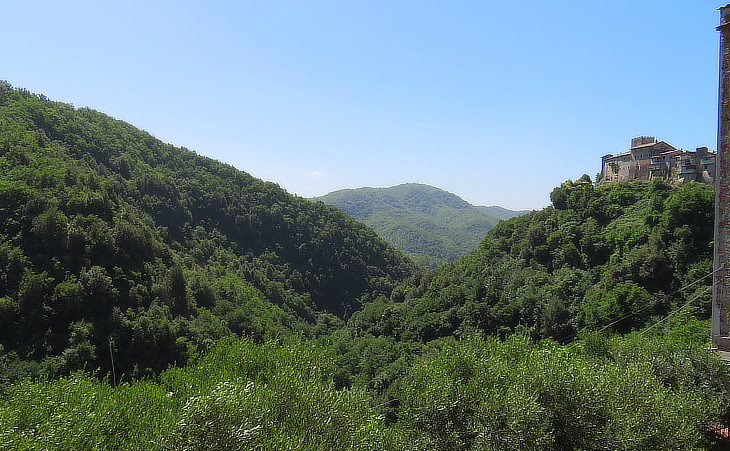
## Valley of the River Licenza seen from the town of Licenza
In 1769 Bertrand Capmartin de Chaupy (1720-1798), a Roman Catholic priest, published Decouverte de la Maison de Campagne d'Horace, the results of an extensive search to find Horace's summer home in the Sabine hills, near modern Tivoli. Around 34 B.C. Horace was presented with a farm by [Maecenas](Vasi126.htm#Auditorium di Mecenate) and it is felt that the rural atmosphere inspired many passages in his "Odes" and "Epistles". A visit to the assumed site of the house became a must for those who toured Italy to study in detail its antiquities. The interest in Horace was partly due to the fact that his poems were part of the Latin learning school programmes of the upper classes.
## Then farewell, Horace, whom I hated so Not for thy faults, but mine; it is a curse To understand, not feel thy lyric flow, To comprehend, but never love thy verse.
Byron - Childe Harold - Canto IV May 15th, 1802. We rose about three in the morning, and although the weather appeared rather lowering, mounted at four, and forming a party of nine proceeded from Tivoli on our road towards the Sabine mountains, to visit Horace's villa at Roccagiovine. (..) As we advanced (from San Cosimato) we found ourselves in a fine valley with beautiful hills rising close on our left, while on our right in the midst of fertile meadows, bounded on the opposite side by the hill of Mandela, and a ridge of successive mountains glided the Licenza, anciently the Digentia, the favorite stream of Horace. Its bed is wide, stony, and shallow in summer. John Chetwode Eustace - A Classical Tour through Italy in 1802
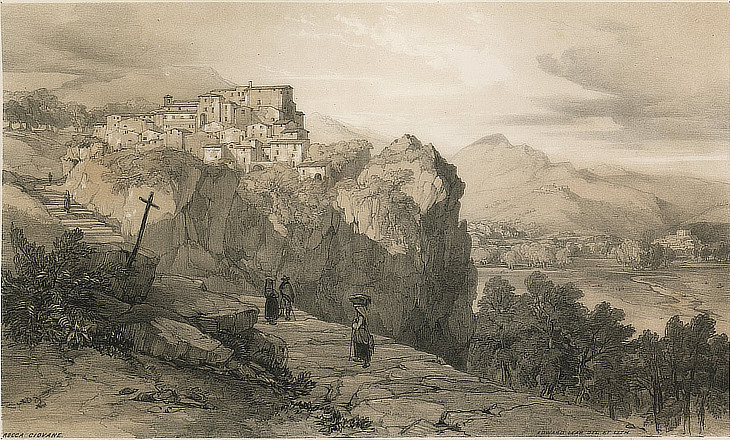
## "Rocca Giovane", lithograph by Edward Lear (ca 1840)
We had not proceeded far when to the left, on the brow of a craggy steep we perceived the Fanum Vacunae, whence the poet dated one of his philosophic epistles; it was almost in ruins in his time and probably sunk under the pressure of age not long after; a village has risen upon its site, and assumed the name of Rocca Giovane. Near the path which leads up to this village issues a spring, called by some writers, the fountain of Bandusia. (..) Vacuna was the Minerva or perhaps the Victory of the Sabines. The temple here alluded to, or one to Victory on the same site was repaired by Vespasian. This goddess had another temple or at least a grove near Reate and the Velinus. Eustace Rocca Giovane. A vllage perched on a high rock, very near the road from Vico Varo to Licenza. It has two hundred and eighty inhabitants. Rocca Giovane has been supposed, and not without reason, a corruption of Rocca Giunone, (Arx Junonis). William Gell - The topography of Rome and its vicinity - 1834
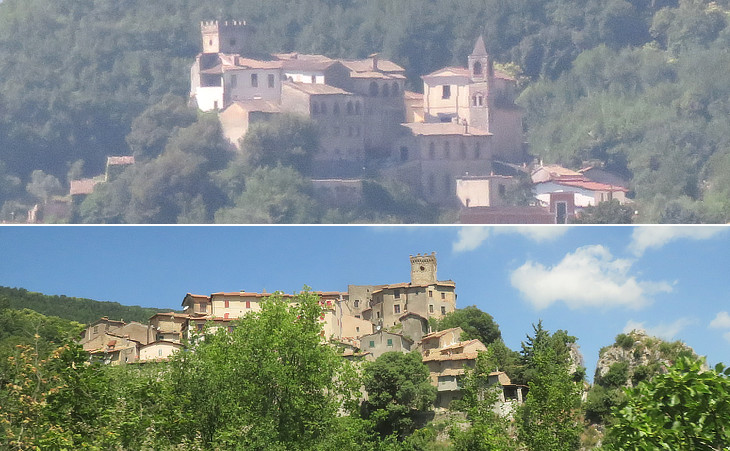
## Roccagiovine seen from: (above) Licenza; (below) at close range (see it from Mandela)
In 1847 Marquis Alessandro del Gallo di Roccagiovine married Julie Bonaparte, cousin of Emperor Napoleon III. The latter promoted excavations of the Palatine which were conducted by archaeologist Pietro Rosa. At the request of Julie Bonaparte, Rosa explored the countryside near Roccagiovine and he established that some ruins near it were the remaining evidence of Horace's farm. This assertion led Alessandro del Gallo to give the almost miserable village of Roccagiovine a more dignified aspect by building a medieval town (this occurred also in other small towns near Tivoli (e.g. at S. Gregorio in Sassola). I have purposely abstained from giving an account of the socalled remains of the farm because it is not possible to identify them. Even granted that the farmhouse should have been preserved during the four centuries of the empire, in memory of the poet's sojourn in this valley, the remains attributed to it by local tradition are too faint and vague to repay the fatigue and the trouble of a pilgrimage. They consist of a piece of mosaic pavement in black and white, of geometrical pattern. Around this poor relic there are vestiges of three terraces of a much later date than the Augustan era, and of such magnificence that they could not possibly be reconciled with the idea of a farm. These vestiges are to be seen on a spur of the Colle Rotondo (Lucretilis?) on the left of the road ascending to Licenza, five hundred yards before reaching the first house. The plateau stands 1320 feet above the sea. (..) Another group of ruins is marked much nearer the village of Roccagiovane; and here, a little above the country church of Santa Maria delle Case, the late explorer of the Campagna, Pietro Rosa, places the site of the farm, in opposition to Sir William Gell and Nibby, who favor Licenza. Rodolfo Lanciani - Wanderings in the Roman Campagna - 1909
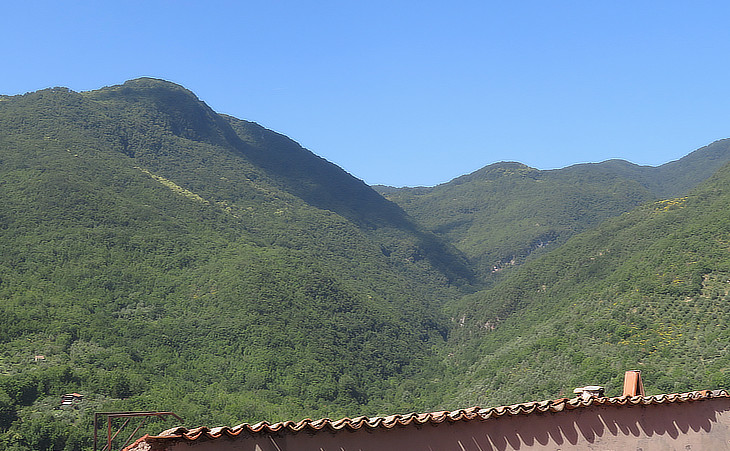
## The Lucretili Mountains seen from Licenza; their western side includes Monte Gennaro
The road then ran at the foot of Mount Lucretilis, and a more beautiful mountain has rarely been discovered by a traveller or celebrated by a poet. It rises in a gentle but irregular swell, forming several hills of different shapes as it ascends, and leading the eye through various easy gradations to its summit. Rocks and precipices frequently break its lines, and open various caverns and grottos in its sides, and on its declivities. Its lower regions are divided into corn fields and vineyards, groves of olives and of chestnuts interspersed with forest, trees thrown negligently about, sometimes single, sometimes in clumps and now and then in woods; its upper parts are healthy pasture, and in many places covered with brambles, shrubs and forests. Herds may be seen ranging through the meadows, and flocks of goats spread over the wilds and browsing on the precipices. Arcadia itself could scarcely have exhibited more beautiful scenes, or opened more delightful recesses; so that Lucretilis, without being indebted to poetical exaggeration for the compliment, might easily be supposed to have attracted the attention of the rural divinities, and allured them to its delicious wildernesses. Eustace Cornazzano. A lofty, precipitous, and well-wooded mountain, between Licenza and Monte Gennaro. Cornazzano has been supposed the ancient Lucretilis. It is one of the most beautiful mountains in Italy, being finely shaped, and also covered with forests. (..) For those who are fond of mountain rambles, no country offers such temptations as the secluded and beautiful neighbourhood of Digentia. The whole neighbourhood is so different from others in Italy, that the passion conceived for it by the poet is quite intelligible to those who visit this cool retreat. Gell Today the Lucretili Mountains and Monte Gennaro are one of the best hiking trails in the environs of Rome.
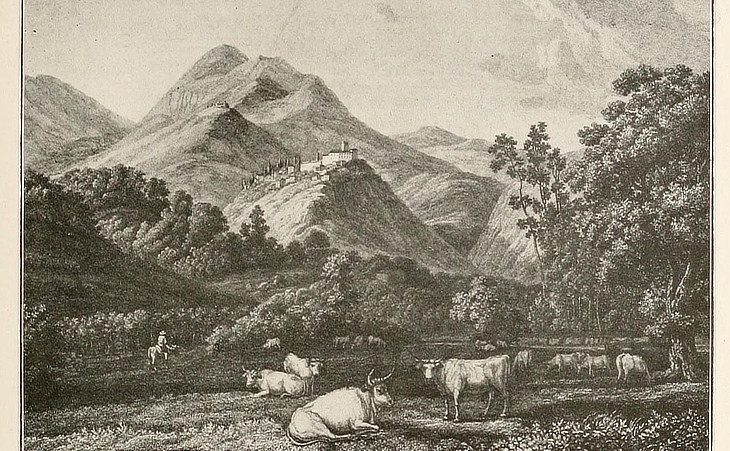
## Licenza and Civitella seen from the assumed site of Horace's house by Georg and Philipp Hackert (ca 1780) from "Rodolfo Lanciani - Wanderings in the Roman Campagna - 1909" (see other views by the Hackert: Rome from Monte Mario, Isola del Liri near Sora, Mount Vesuvius and the Temple to Juno at Agrigento)
The celebrated artist-engraver, Georg Hackert, with the help of his brother Philipp, produced an exquisite album of eleven views of the district of Tivoli. The reader can appreciate the beauty of Hackert's work from the specimen here reproduced. It represents the view which Horace must have enjoyed whenever, sitting on the banks of the noisy river, at the foot of the hill on which the farm buildings stood, he turned his gaze northward in the direction of Licenza and Civitella. Lanciani About a mile and a half beyond the road which leads to Rocca Giovane we turned up a pathway, and crossing a vineyard found ourselves on the spot where Horace's villa is supposed to have stood. A part of a wall rising in the middle of brambles, and some mosaic pavements, are the only traces that now remain of the poet's mansion. It was probably remarkable neither for its size nor its decorations; neatness and convenience it must have possessed. Its situation is certainly extremely beautiful. Placed in a little plain or valley in the windings of Mount Lucretilis it is sheltered on the north side by hills rising gradually but very boldly; while towards the south a long hillock, covered with a grove, protects it from the scorching blasts of that quarter. Being open to the east and west it gives a full view of Rocca Giovane on one side; on the other, two towns, the nearest of which is Licenza, the farthest Civitella, perched each on the pointed summit of a hill present themselves to view. Behind the house a path, leading through a grove of olives and rows of vines, conducts to an abundant rill descending from Fonte bello a fountain in the higher regions of the mountain. It is collected in its fall fron an artificial cascade into a sort of bason, whence it escapes pours down the hill and glides through the valley, under the name of Digentia, now Licenza. This rill, if I may judge by its freshness, still possesses the good qualities Horace ascribed to it some centuries ago, and still seems to flow so cool and so clear. I must indeed here observe, that the whole tract of country which we have just traversed corresponds in every particular with the description which Horace gave of it two thousand years ago: Not only the grand and characteristic features - the continued chain of mountains - the shady valley - the winding dell - the abundant fountain - the savage rocks - features which a general convulsion of nature only can totally efface not those alone remain, but the less and more perishable beauties - the little rills - the moss-lined stones - the frequent groves - the arbutus half concealed in the thickets - the occasional pine - the oak and the ilex suspended over the grotto - these meet the traveller at every turn, and rise around him as so many monuments of the judgment and the accuracy of the poet. We were less fortunate in this poetical pilgrimage than usual, as a heavy rain began about twelve o'clock in the day, and accompanied by strong gusts of wind continued pouring in an incessant torrent till twelve at night. It soon penetrated our clothes; the tardiness of our mules gave it full time to operate; so that notwithstanding our enthusiasm and a few occasional bursts of merriment we paced slowly along the Via Valeria wet and benighted till we reached Tivoli about ten o'clock. Thus we learned by experience, that Horace had some reason to thank the rural divinities for protecting his flocks from the inclemencies of the mountains, and from the rainy winds, whose effects he seems to have felt and dreaded. Eustace

## Civitella seen from Licenza
This Civitella is in the vicinity of Licenza, on a high peaked summit, exceedingly difficult of approach. It has not many inhabitants. The name Civita, and its derivations, seem very frequently to indicate the remains of ancient towns and cities. As (..) the classic authors have left us very little detail with regard to the towns of this neighbourhood, it is not now possible to discover the name of that which may have existed at Civitella. A place so perched on a lofty summit, surrounded by still higher peaks, exhibiting an amazing variety of mountains, woods, and precipices, could not fail to be picturesque; and the recollection that Horace must have admired the view every time he approached the windows of his Sabine retreat, gives additional interest to what, independently of this, is one of the most beautiful scenes in Italy. (..) This secluded and beautiful country has been hitherto little examined. It is possible that, in its remote valleys, and on its hills, might yet be found other names of classic origin. Above Civitella are rugged and unfrequented mountain paths, leading to Monte Flavio andMoricone. Gell
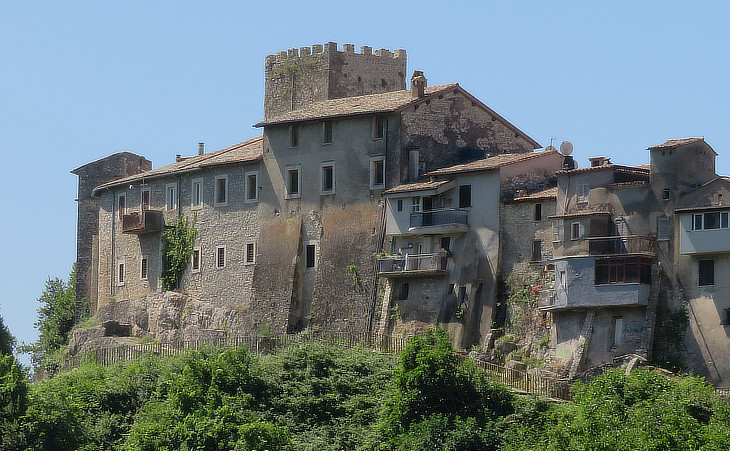
## Licenza: Castello Orsini on the edge of the rock
There can be little doubt that the modern village of Licenza is the representative of the ancient Digentia, though this is better known as a river than as a village. There are now six hundred and seventy-three inhabitants. Gell A typical characteristic of the landscape of the Apennines is to show evidence of Roman towns and monuments in the valley and medieval towers perched on an eagle's nest, e.g. at Gubbio. This can be noticed also in the valley of the River Licenza, where a precipitous rock permitted a handful of men to control the access to a small settlement. See a similar situation at Alba Fucens east of Licenza. The village was acquired by the Orsini, one of the most powerful Roman families, in the XIIIth century. It was part of a string of fiefdoms which at one point stretched from the Tyrrhenian Sea to the heart of Abruzzo.
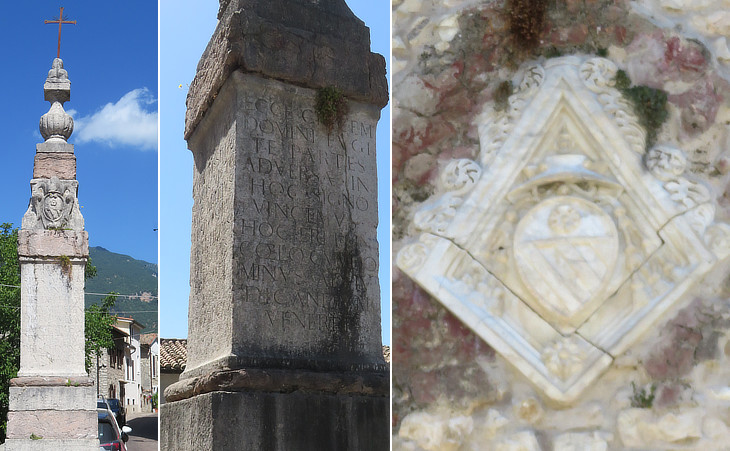
## (left) Obelisco della Croce, 1615 small monument at the old entrance to the town; (centre) inscription which in part is a copy of those of Obelisco Vaticano; (right) reconstructed coat of arms of Bishop Mario Orsini on the tower of the castle
The Orsini family eventually split into several branches and one of them was only in possession of Licenza and Roccagiovine. The main representative of this branch is Mario, a cadet who embraced the ecclesiastical career. In 1611 he was appointed Bishop of Bisignano, a small diocese in Calabria, which directly reported to the Pope and thus was assigned to members of Roman families. In 1624 he became Bishop of Tivoli until his death in 1634. He erected a sort of obelisk at the entrance to Licenza which in part is made of pink granite stones and has on top three mountains, the heraldic symbol which Pope Sixtus V placed on the obelisk which he moved to Piazza San Pietro in 1586.
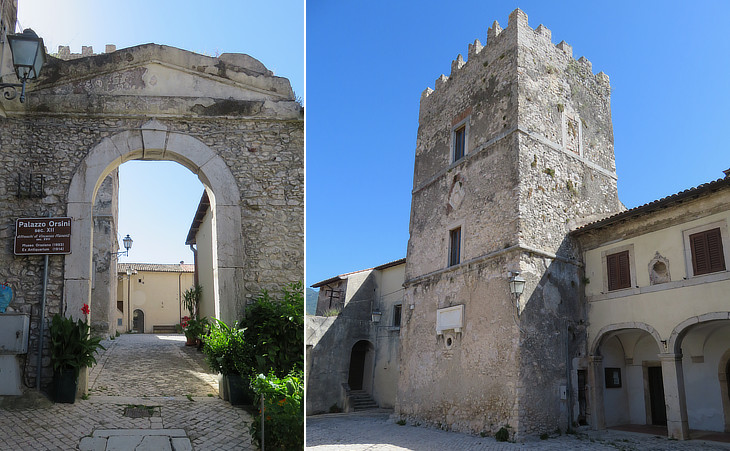
## Castello Orsini: (left) main gate; (right) medieval tower
In the early stage of the development of the medieval settlement the whole population lived inside the castle. Later on houses were built along Borgo Vecchio the uphill street which leads to it. The tower bears the following inscription: 18 - NOVEMBRE - 1935 - XIV //A RICORDO DELL'ASSEDIO PERCH� RESTI DOCUMENTATA NEI SECOLI// L'ENORME INGIUSTIZIA// CONSUMATA CONTRO L'ITALIA// ALLA QUALE //TANTO DEVE LA CIVILT� // DI TUTTI I CONTINENTI. Assedio means siege but it is difficult to figure out an army laying down a siege to conquer Licenza. As a matter of fact the pompous inscription does not refer specifically to the town but to the whole of Italy which was economically sanctioned by the League of Nations for having invaded Ethiopia in 1935. The government ordered that an identical inscription made by a factory near the marble quarries of Carrara should be placed in all Italian towns. It has since been removed almost everywhere.
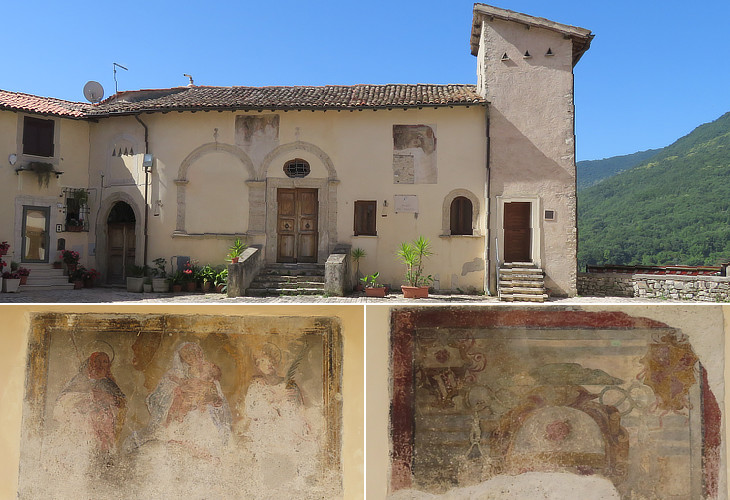
## Castello Orsini: (above) western part of the castle; (below-left) fresco portraying the Virgin Mary between two saints; (below-right) coat of arms of Bishop Mario Orsini and above it those of his parents
During the XVIIth century the Orsini redesigned the castle which lost most of its military aspect. Some frescoes indicate that this was done at the initiative of Mario Orsini, who as Bishop of Tivoli could rely on some substantial revenues and in addition to this was in friendly terms with [Pope Urban VIII](Storia24.html#Urban VIII) who wanted him among his assistants. In the late XVIIth century the Orsini sold many of their fiefdoms, e.g. Bracciano to the Odescalchi and Vicovaro to the Bolognetti. Licenza was sold to the Borghese who did not care much about this very small addition to their possessions.
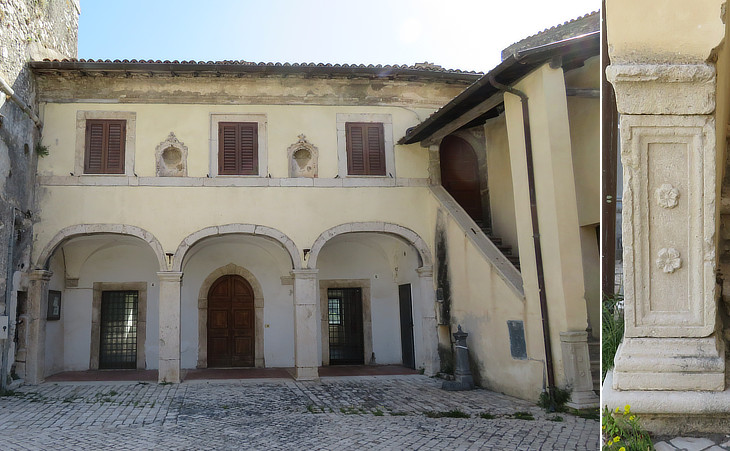
## Castello Orsini: (left) residential part of the castle; (right) five-petal rose of the Orsini
Licenza. This is one of the most interesting of the excursions from Tivoli. A carriage may be taken from Tivoli to the farm of Horace itself, or good walkers may take the morning diligence to Subiaco as far as S. Cosimato, and walk from thence to Licenza, returning to meet the diligence in the evening. (..) The road comes to an end on the margin of the clear brook Digentia, which is here sometimes swollen into a broad river by the winter rains. On the further side of the wide stony bed it has made for itself, rises Licenza cresting a high hill and approached by a steep rocky path through the olives. Just where the road ends, a steep bank covered with chestnuts rises on the left. Passing through the wood to a garden, we find a "contadino" who shovels up the rich loam with his spade, exposes a bit of tesselated pavement, and says "Ecco la villa d'Orazio." Augustus J. C. Hare - Days near Rome - 1875. In 1911-1914 extensive excavations were carried out on the assumed site of Horace's farm at the initiative of the Italian State. Archaeologists uncovered a relatively luxury villa of the second half of the Ist century AD and names on bricks and lead pipes suggested that its landlords had connections with Emperors Nero and Domitian. No specific evidence of Horace was found but his presence at this site cannot be ruled out. The image used as background for this page shows a XIXth century portrait of the poet.